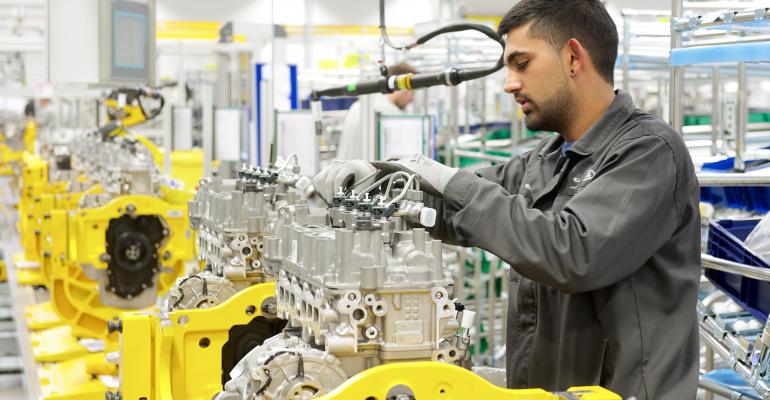Jaguar Land Rover opens its £500 million ($798 million) Engine Manufacturing Center to produced engines in-house for the first time in a generation.
Located near Wolverhampton in the West Midlands, the center will produce the Ingenium engine family, which will power a new generation of JLR products designed, engineered and manufactured in the U.K.
It starts with the 2.0L diesel that officially roll off the production line early next year, destined for the new Jaguar XE.
Last year, JLR sales rose 19% to 425,006 units, with Jaguar accounting for 76,668 units and Land Rover 348,338.
CEO Ralf Speth says JLR is drawing on the expertise of 2,000 powertrain engineers who have been inspired by the company’s 70-year heritage in the design and development of iconic engines.
“These engineers, together with the new 1,400 strong team at the Engine Manufacturing Centre, will deliver the next generation of highly efficient, ultra-low emission 4-cyl. petrol (gasoline) and diesel engines,” Speth says in a statement.
The 107,639-sq.-ft. (100,000-sq.-m) facility houses an engine-testing center alongside manufacturing and assembly halls and is described as meeting the highest standards of sustainable production.
It is home to the U.K.’s largest rooftop solar-panel installation, with 21,000 individual panels. It is estimated the panels will generate more than 30% of the plant’s energy requirements, providing the same amount of energy required to power 1,600 homes.
Center Operations Director Trevor Leeks says the facility is an important step in advancing the competitiveness and capability of the U.K. automotive sector.
“The production of in-house engines will support the expansion of the U.K. supply chain, providing critical mass for inward investment,” Leeks says.
Meantime, the Society of Motor Manufacturers and Traders says revenue generated by engine manufacturing in the U.K. is expected to increase by up to £2.5 billion ($4 billion) in two years, boosting revenue 31%.
More than £1 billion ($1.6 billion) has been spent on U.K. engine production since 2011 and forecasts suggest the value of engine manufacturing will increase to £10.5 billion ($16.8 billion) by 2016.
The SMMT says development programs such as that by JLR and Ford’s £490 million ($782.6 million) low-carbon engine development in Dagenham are helping ensure the U.K. is at the cutting edge of powertrain development and production.
Development programs such as these will help total U.K. engine output surpass 3 million units a year, increasing volumes by more than a fifth over current levels.
SMMT CEO Mike Hawes says the JLR and Ford development projects are clear evidence of the U.K. automotive industry’s intention to become a leading force in the design, development and manufacture of engines.
“The recent success is testament to the expertise of U.K. engineers, a flexible work force and the competitive and supportive business environment,” he says in a statement. “It will create more jobs, bolster the supply chain and help attract overseas suppliers back to U.K. shores.”
The country last year produced 2,553,316 engines, with 60% exported.
The SMMT says engine production fell 13.6% year-on-year in September to 211,185 units, as facilities underwent retooling for new products. This left year-to-date production down 5.0% at 1,821,941 units.
Production for the domestic market fell 7.3% in September to 87,774 units, while export output slipped 17.6% to 123,411 units.
After 10 months, the engine build for the domestic market was down 14.4% at 664,908 units, while export production was up 1.4% at 1,157,033 units.





